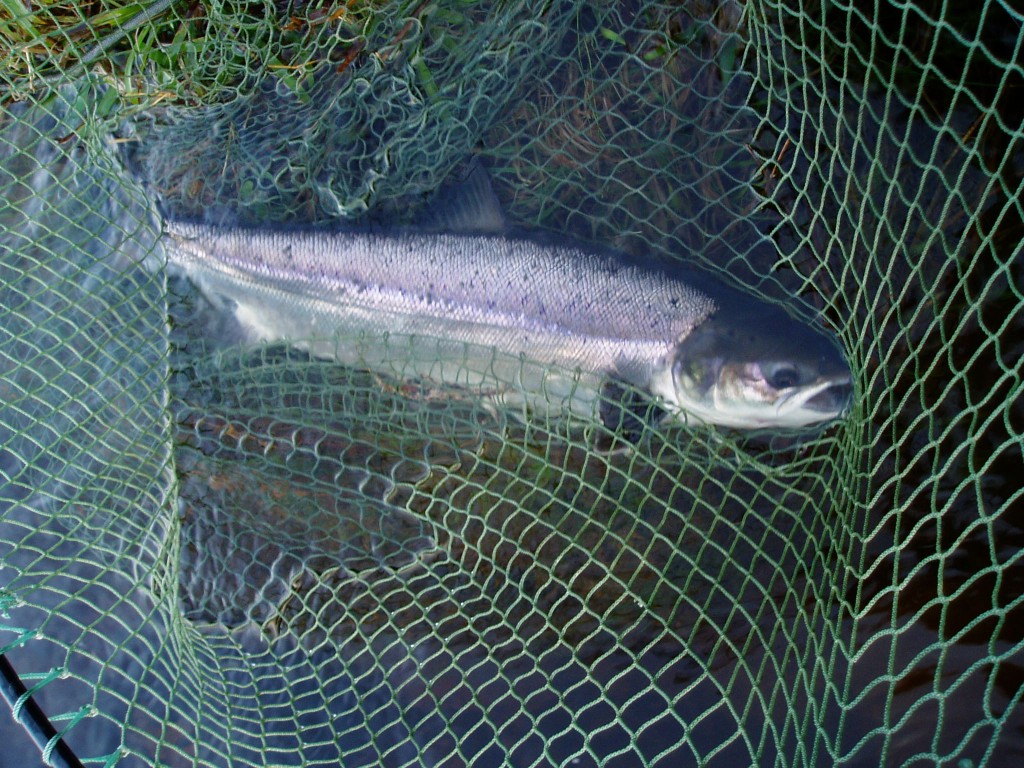The last two weeks has been wet. Autumn has arrived early with some trees in full colours. And the South Esk has run big and dirty, making it impossible to fish for a large part of the last week. Despite this, some of our local anglers have managed to catch the occasional salmon. Nothing big, but last Friday my brother, John, and I caught 4 nice salmon up to 12lbs, three of them in Willows and one in the Red Brae. Two of these fish were bright silver; genuine autumn-running salmon. There have been one or two MSW salmon in the teens of pounds showing in the main pools, with Marcus House Pool as good a place as any for an exciting encounter. A big spate over last weekend flooded the woodlands along the banks of the Red Brae and Nine Maidens. Bankside benches were moved around by the flood, and a small boat was stranded in the wood below Indies. We are claiming salvage!
At this time of year we see the proportion of silver salmon to coloured fish diminish rapidly. By the end of October you can expect one fish in four to be silver, whereas at the beginning of the month it is more likely to be one to two. People ask me whether catch and release has made it acceptable to fish for gravid salmon, whilst in the past people placed the emphasis on firm-fleshed, fresh run fish. The truth is that a large cock salmon, defending its territory aggressively as a precursor to spawning, will fight hard and long for its life, perhaps better than a fresh-run fish exhausted after its upstream migration to the pool of its capture. In terms of sport therefore, as many people define it, the red cock fish offers the angler a real battle.
I have always felt a bit uneasy about fishing for salmon that are close to spawning, but as salmon fishermen we have to accept that this is a facet of autumn salmon fishing. In other words, if you are going to catch one of those glorious fifteen pound sea-liced autumn salmon, we must accept that to do so will involve catching and releasing an increasing number of red fish as the last month of the season wears on. Our responsibility as conservation-minded anglers is to return these neo-spawners to the water so that they survive to complete the purpose of their migration.
Returning a fish safely can be a cold and lengthy process. If you can possibly manage to unhook the fish without taking it out of the water you will greatly enhance its chances of survival. If at all possible you should bring the fish to the net quickly, unhook it in the net and then gently hold the fish, with its head facing upstream, until it swims away from you. It is important to hold the fish gently, and not to squeeze its body. One very successful way of reviving an exhausted salmon is to place your finger laterally across and inside its mouth. You will feel the rather pleasant sensation of the fish chewing your finger with its cartilage mouth (no teeth!) in rhythm with the working of its gills. This action seems to revive the fish and restore its will to escape. Try it: it really works! It is also worth noting that to catch and release a salmon successfully it is important that the fish should not have its slime ‘envelope’ broken or get sand and grit in its gills. It is therefore not a good idea to beach a fish, although sometimes, with very big salmon, this method is necessary.
The pools at Finavon are now all full of fish and as the water level drops and the nights become frosty they will be easier to catch. The next three weeks, if the falling autumn leaves and water levels allow, we should see some of our best catches of the season. The wild geese are back, the swallows have gone and the nights are drawing in. These are the last days of the 2010 season, and I hope my next report will tell of some good fish landed. As I write this on the 4th of October our season’s catch is 84 salmon and 112 sea trout.
TA
